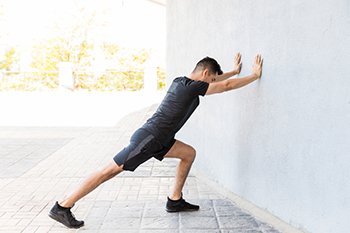3320 North Buffalo Drive
Suite 107
Las Vegas, NV 89129

When athletes, and especially runners, stretch tight calf muscles, they may be doing more harm than good to the Achilles tendon, experts say. Short active stretches may be more beneficial than passive stretching, where the heel is pressed downward and held for an extended period of time. Research has shown an overload on the Achilles tendon can cause it to become inflamed. When a typical calf/Achilles tendon stretch is performed, it’s normal for the tendon to press against the heel bone. However, when this position is gained too forcefully or sustained for too long it can become a problem. In fact, it is believed that overdoing a heel drop stretch of the Achilles tendon and calf can actually contribute to Achilles tendonitis. For this reason, experts recommend a heel drop flat against the floor rather than from a stair step, where the heel goes below the horizontal plane. Instead, massage, foam rolling, and double heel raises can help do the job of relieving tightness. For more detailed guidance on how to avoid Achilles tendonitis, please consult a podiatrist.
Achilles tendon injuries need immediate attention to avoid future complications. If you have any concerns, contact one of our podiatrists of Summerlin Foot & Ankle. Our doctors can provide the care you need to keep you pain-free and on your feet.
What Is the Achilles Tendon?
The Achilles tendon is a tendon that connects the lower leg muscles and calf to the heel of the foot. It is the strongest tendon in the human body and is essential for making movement possible. Because this tendon is such an integral part of the body, any injuries to it can create immense difficulties and should immediately be presented to a doctor.
What Are the Symptoms of an Achilles Tendon Injury?
There are various types of injuries that can affect the Achilles tendon. The two most common injuries are Achilles tendinitis and ruptures of the tendon.
Achilles Tendinitis Symptoms
Rupture Symptoms
Treatment and Prevention
Achilles tendon injuries are diagnosed by a thorough physical evaluation, which can include an MRI. Treatment involves rest, physical therapy, and in some cases, surgery. However, various preventative measures can be taken to avoid these injuries, such as:
If you have any questions please feel free to contact our office located in Las Vegas, NV . We offer the newest diagnostic tools and technology to treat your foot and ankle needs.